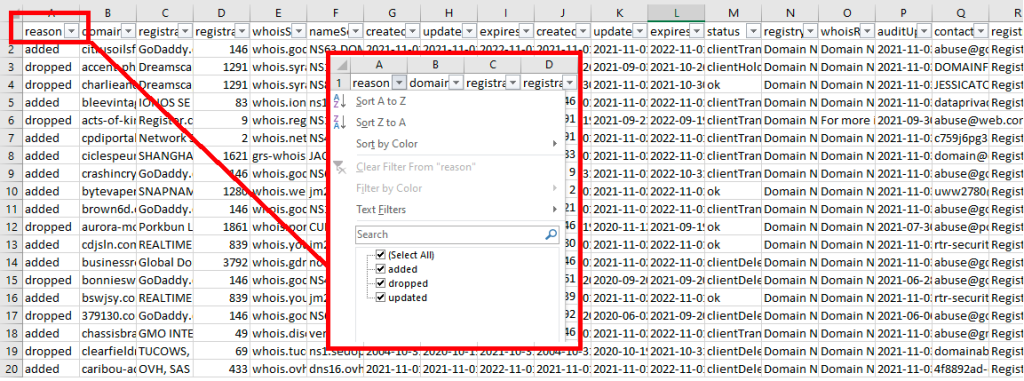WhoisXML API’s Newly Registered & Just Expired Domains Database 2.0: Getting Started

WhoisXML API’s Newly Registered & Just Expired Domains Database service has a new and improved version called “NRD 2.0.” Among other improvements, it offers better coverage and is easier to use than its predecessor. Learn more about NRD 2.0 in this guide.
What Are the Main New Features of NRD 2.0?
Depending on your chosen package, NRD 2.0 features the following changes compared to NRD 1.0:
- More new domain event types: Besides monitoring NRDs (domain names registered within the last 24 hours, plus domains created within the last 7 days) and just-expired domains (domains that expired within the last 24 hours, plus domains expired within the last 7 days), NRD 2.0 also tracks newly updated domains or those whose WHOIS records changed within the last 24 hours, plus those with WHOIS record changes within the last 7 days. NRD 2.0 also monitors newly discovered domains or those that have been previously unknown and created more than 7 days ago.
- Coverage of both gTLDs and ccTLDs: While only domains sporting gTLDs were available in NRD 1.0, NRD 2.0 now covers ccTLDs to let users also keep track of country-specific domain names.
- TLD stats files: Each NRD 2.0 daily file containing raw domain records is accompanied by a summary stats file that specifies the number of records per TLD on that day.
- Daily unified files covering all TLDs: NRD 2.0 files are unified into a single daily file covering all TLDs rather than being made part of TLD-specific files.
- Format alternatives: NRD 2.0 daily files come in both JSON and CSV file formats.
Which NRD 2.0 Plans Are Available?
NRD 2.0 offers five types of subscription plans—Lite, Basic, Professional, Enterprise, and Ultimate (including Ultimate: Simple). Different plans have different data features, as detailed below.
Lite
Under the NRD 2.0 Lite package, users are informed about new domain registrations only. Below is an example of a Lite NRD file, which contains two columns. You can download a sample of this package here.

Basic
Basic package users can see the newly registered and just-expired domains in a single file. The “reason” column can be filtered so they can see which domains were either dropped or added. You can download a sample of this package here.

Professional
Under the Professional package, users enjoy the benefits of the Basic plan, along with the complete WHOIS information of the newly added and just-expired domains. The files appear similar to those for the Basic plan but come with additional WHOIS data columns for each domain. Take a look at the sample of this package for more information.
Enterprise
The NRD 2.0 Enterprise package provides users access to all supported TLDs. While the Lite, Basic, and Professional packages only cover gTLD domains, the Enterprise package also covers ccTLD domains. Also included are newly updated domains or those whose WHOIS records were recently changed, along with those that were newly registered and just expired and their WHOIS record details. Take a look at this sample if you’re interested in testing this database in your environment.

Ultimate
Ultimate package users enjoy all the data, TLD coverage, and features of the Enterprise package. On top of that, they can access newly discovered domains or those that have recently been added to the DNS even though their registration dates are not recent.
Users can filter the “reason” column to view only added, discovered, dropped, or updated domain names. You can also check out this sample to explore the data in your own environment.

Ultimate: Simple
Ultimate: Simple, which is part of the Ultimate package, contains the same data minus the raw text columns (e.g., rawText, registryDataRawText, registrantContact.rawText, whoisRecordRawText, etc.). This omission makes Ultimate:Simple daily files lighter and therefore faster to download and easier to integrate into existing systems since they require less data processing overall. You can check out this sample for more information.
What Does the NRD 2.0 Stats File Contain?
As an added NRD 2.0 feature, we gave users the ability to see the number of domains included in raw daily files per TLD. Stats files are also available with all subscription plans and has two columns, namely:
- “tld” column: This column lists the TLDs arranged alphabetically.
- “records” column: This column contains the number of domains under a specific TLD on a particular date.
The image on the left shows the original arrangement of the TLDs. The one on the right, meanwhile, has been arranged according to number of records (from highest to lowest).

What Common Use Cases Does NRD 2.0 Enable?
1. Brand Protection
Brand impersonators and trademark infringers can damage an organization’s reputation in several ways, one has to do with domain name registration. They may use a brand name alongside other text strings and different TLDs in bad faith. Some of the illicit reasons for domain brand impersonation are:
- Selling counterfeit versions of your or your competitors’ products
- Attracting traffic using your brand’s reputation and popularity
- Sending spam or phishing messages using your brand name
NRD 2.0 helps organizations keep track of NRDs that use their brand names or their variations. In the sample NRD data feed below, for example, 20 domains contained the text string dior.

While the list could contain false positives, integrating it into your brand protection system can alert you to brand impersonators.
2. Threat Intelligence Enrichment
You can also use NRD 2.0 to check for NRDs that use the names of commonly impersonated brands, such as PayPal and Microsoft. Others may also use misspelled variations of these company names, such as “micosoft” and “paypai,” as shown in the screenshots below.

Detecting and blocking suspicious domains off the bat is one thing. You can also enrich your threat intelligence by investigating their ownership data. Our Professional, Enterprise, and Ultimate packages include the WHOIS records of all domains so you can deepen your threat investigations.
3. Competitor and Market Analysis
NRD 2.0 can also provide a glimpse of what’s happening in the market and to your competitors. The database allows you to answer questions, such as:
- What new businesses recently joined the market?
- Are your competitors venturing into partnerships and similar opportunities?
- What businesses are operating in a particular location?
- How intense is the current market competition?
Below is a demonstration of how NRD 2.0 can offer certain details that can contribute to addressing the last question. A total of 297 NRDs contained the string insurance in the sample data feed. Analyzing word combinations and WHOIS records can give you insights into what’s happening in the insurance industry.

Conclusion
WhoisXML API’s improved NRD database NRD 2.0 can be easily integrated into your existing business systems, including threat intelligence platforms, brand protection tools, and market analysis solutions. Contact us for more information about our different subscription plans or if you have any questions.



































